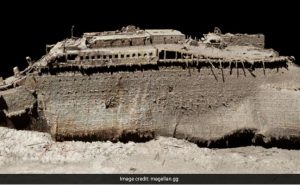
First Full Digital Scan Captures Titanic Shipwreck.

The publication of the first full-sized 3D scan of the Titanic shipwreck has brought forth the potential to uncover further details about the tragic journey of the ocean liner over a century ago.
These high-resolution images, released by the BBC, offer a meticulous reconstruction of the wreck, lying at a depth of nearly 4,000 meters (13,100 feet), and were created using deep-sea mapping technology.
The luxurious passenger liner met its fate after colliding with an iceberg during its inaugural voyage from Southampton, England, to New York in April 1912, resulting in the loss of over 1,500 lives.
Although extensive exploration of the shipwreck has taken place since its discovery in 1985, approximately 650 kilometers (400 miles) off the Canadian coast, cameras had never been able to capture the complete ship in its entirety.
The reconstruction project, undertaken in 2022 by deep-sea mapping company Magellan Ltd and Atlantic Productions, was conducted as part of an upcoming documentary. Specialized remotely controlled submersibles spent over 200 hours meticulously surveying the wreck on the ocean floor, capturing over 700,000 images to create the scan.
Gerhard Seiffert, leading the planning for the expedition at Magellan, explained that the team was prohibited from physically touching anything to avoid damaging the wreck. He also highlighted the challenge of mapping every square centimeter, including mundane areas like the debris field, as they contribute to filling in the gaps between significant objects.
The images from the scan depict the separated stern and bow of the wreck surrounded by debris, seemingly lifted from the water and offering unprecedented clarity, down to the smallest details, such as the serial number on one of the propellers.
These new scans hold the potential to shed further light on the circumstances surrounding the liner’s demise. Historians and scientists are racing against time, as the ship continues to disintegrate, in their quest to uncover more insights.
Parks Stephenson, a long-time Titanic researcher, expressed his enthusiasm for the project, stating, “Now we are finally getting to see Titanic without human interpretation, derived directly from evidence and data.” Stephenson further emphasized that there is still much to learn from the wreck, which essentially serves as the last surviving eyewitness to the disaster.
“With these scans, the Titanic has stories to tell,” he added.
The release of the full-sized 3D scan marks a significant milestone in our understanding of the Titanic’s tragic history. The intricate details captured in the images pave the way for further exploration and analysis, opening up a new chapter in unraveling the secrets held by this iconic shipwreck.
